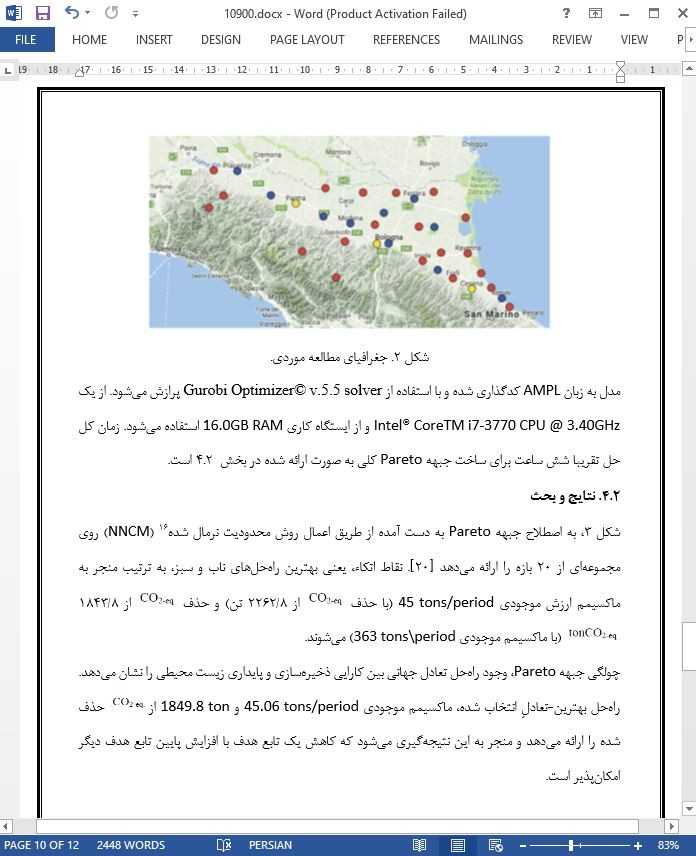
مدل کارایی و پایداری برای طراحی و مدیریت شبکه های لجستیک دو مرحله ای
چکیده
کارایی توزیع و ذخیرهسازی همراه با پایداری زیست محیطی، اهداف مهمی هستند که باید در هنگام طراحی و مدیریت شبکههای زنجیره تامین (SC) مدرن در نظر گرفته شود. تحقیقات اخیر به طور پیوسته به دنبال مدلها و راهکارهای چندبعدی کمّی، از جمله مدلها و راهکارهایی برای متعادل ساختن چنین مسائل واگرایی به بهترین شیوه هستند. این مقاله، مدل بهینهسازی دو منظورهای را برای طراحی و مدیریت کارامد شبکههای لجستیک دو مرحلهای که به دنبال بهترین مبادله بین سطح موجود SC و تاثیر زیست محیطی توزیع و ساختمان هستند ارائه داده و اعمال میکند. وجود تعادل خوب، امکان کاهش متوسط سطح موجودی SC بدون افزایش مربوطه انتشارات ناشی از بازپرسازیهای مکرر را تایید میکند.
۱. پیشگفتار
مدیریت ناب (LM)، فلسفهای صنعتی با هدف افزایش بهرهوری و کاهش هزینهها و فعالیتهای بدون ارزش افزوده در قالب تولید بیش از حد، حمل و نقل، موجودی و نقصها است. هدف اصلی LM، حذف زباله است. مدیریت سبز (GM)، تفکر زیست محیطی، شامل طراحی محصول پایدار، تهیه و انتخاب مواد کم کربن، فرایندهای تولید سبز، مدیریت پایان عمر، و لجستیک (تدارکات) معکوس محصولات در پایان طول عمر آنها را در مدیریت زنجیره تامین (SCM) ادغام میکند [۱]. LM و GM دارای هدف مشترک حذف زباله هستند اگرچه تمرکز آنها روی انواع مختلف زباله باشد. تعدادی زیادی از محققان به بررسی مزایای پیادهسازی جداگانه این دو روند میپردازند. تحقیقات اندکی وجود دارند که به بررسی ادغام بین LM و GM در زمینه SCM، به ویژه از چشماندازی کمّی، یعنی مدلبندی، میپردازند. ترکیب LM و GM میتواند منجر به نتایجی بسیار بالاتر از مجموع عملکردهای به دست آمده از اعمال جداگانه آنها شود.
۵. نتیجهگیریها و پژوهشهای آینده
امروزه مدیریت ناب (LM) و مدیریت سبز (GM)، نقش مهمی در زنجیرههای تامین (SC) مدرن دارند که این امر، نیاز به رویکردی یکپارچه در طراحی و مدیریت SC را نشان میدهد. پیادهسازی همزمان LM و GM، چالش جدیدی است که توسط تعداد کمی از محققان و متخصصان، به ویژه از چشماندازی کمّی، مورد بررسی قرار گرفته است. این مقاله، مدل دو منظورهای را ارائه میدهد که به طور همزمان، LM را در زمینه کارایی ذخیرهسازی از طریق SC، و GM را در زمینه انتشارات زیست محیطی توزیع و ساختمانی، بهینهسازی میکند.
Abstract
The distribution and storage efficiency together with the environmental sustainability are mandatory targets to consider when designing and managing modern supply chain (SC) networks. The current literature continuously looks for quantitative multiperspective strategies and models, including and best balancing such issues that often diverge. This paper presents and applies a bi-objective optimization model to best design and manage two-stage logistic networks looking for the best trade-off between the SC stock level and the building and distribution environmental impact. The existence of good balance confirms the possibility to reduce the average SC stock level without a relevant increase of the emissions due to frequent replenishments.
1. Introduction
Lean Management (LM) is an industrial philosophy aiming to increase productivity and to reduce costs and novalue added activities in the form of overproduction, transporting, inventory and defects. The main goal of LM is waste elimination. Green Management (GM) integrates the environmental thinking in Supply Chain Management (SCM), including sustainable product design, low-carbon material sourcing and selection, green manufacturing processes, end-of-life management and reverse logistics of the products at the end of their lifespan [1]. LM and GM share the common goal of waste elimination even if their focus is on different types of waste. A large number of researchers investigates the benefits of implementing such two practices separately. Few contributions exist in the literature examining the integration between LM and GM in the field of SCM, especially from a quantitative, i.e. modelling, point of view. The combination of LM and GM can lead to great results, higher than the sum of the performance from their separate application.
5. Conclusions and future research
Nowadays Lean Management (LM) and Green Management (GM) play a pivotal role in modern supply chains (SC) suggesting the need of an integrated approach in SC design and management. The joint implementation of LM and GM is a new challenge explored by few researchers and practitioners, especially from a quantitative perspective. This paper presents a bi-objective model simultaneously optimizing LM, in terms of storage efficiency through the SC, and GM, in terms of building and distribution environmental emissions.

چکیده
۱. پیشگفتار
۲. مرور متون پژوهشی
۳. مدل دو-منظوره برای طراحی شبکههای لجستیک
۳.۱. توصیف، فرضیات و نمادگذاریهای مساله
۴. کاربرد مدل
۴.۱. توصیف مطالعه موردی
۴.۲. نتایج و بحث
۵. نتیجهگیریها و پژوهشهای آینده
Abstract
1. Introduction
2. Literature review
3. Bi-objective model for the logistic networks design
3.1. Problem description, assumptions and notations
4. Model application
4.1. Case study description
4.2. Results and discussion
5. Conclusions and future research
- ترجمه فارسی مقاله با فرمت ورد (word) با قابلیت ویرایش، بدون آرم سایت ای ترجمه
- ترجمه فارسی مقاله با فرمت pdf، بدون آرم سایت ای ترجمه
